|
Boat Anchors: One of my first was the Hammarlund HQ-120X
Short Wave Receiver
Recently I re-acquired a taste for the smell and feel of what is commonly
referred to in Ham Radio circles as Boat Anchors, old tube radio's. In the
Menu bar above you will notice a selection of BoartAnchor
pages. In these pages I will describe some of my adventures describing how I
brought back to life a few of my old favorites that take a minute to warm up
and emit warm incandescent light instead of cold monochromatic, either
blinding or difficult to see, LEDs.
During December 2011 my XYL and I were touring the Tacoma, WA Zoo with our
daughter and three grandsons. We were walking through an explores mock-up
cabin and in the corner was an old Boat Anchour, a
tube shortwave radio similar to the one a friend owned when we were first licences. My daughter said "Dad, let me take a
picture of you by that old radio", so I obliged.
An Old Radio
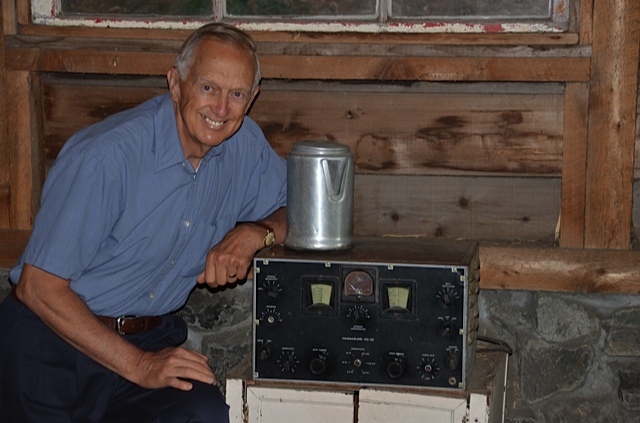
During a return trip in March 2012 to visit our daughter and family my three
grand-sons excitedly ushered me into the living room where there was a
blanket covering a box. The boys said "Papa, close your eyes". When
told to open my eyes what was under the blanket was not a box but the old
radio that we had seen at the Tacoma Zoo. On closer scrutiny we saw that it
was a WWII Hammarlund HQ120X Short Wave Receiver. When we left after
Christmas holidays, my daugher phoned the Zoo and
told them she had a home for that old radio if they decided they didn't neet it any longer. It turned out that they were in the
process of changing the theme of the explorers cabin and in fact they didn't
have a home for the old radio. Shortly after our daughter received a call
from the Zoo and was told if she still had a home for it that she could come
and pick it up. Since I had recently retired my daughter must have thought I
needed a project to keep me out of mischief.
Hammarlund HQ120X Receiver
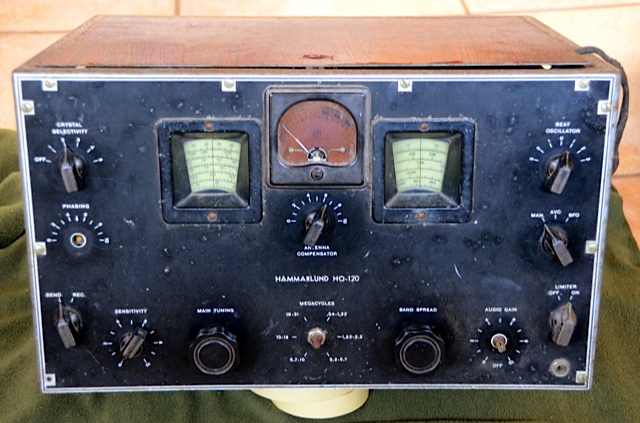
The boys enjoyed helping to vacumn the inside and
take the radio out of the cabinet. We found the radio had been modified
considerably, subsituting some miniture
tubes for the old orginial metal can tubes plus
there were other non Hammarlund components added.
My Helpers

The poor old receiver had seen better days. It was filthy, grimy, there were buned out reistors, it was
rusty and a few knobs and all the tubes but one were missing. The dials
turned though rather stiffly and as you can see it looked in really tough
shape.
The inside
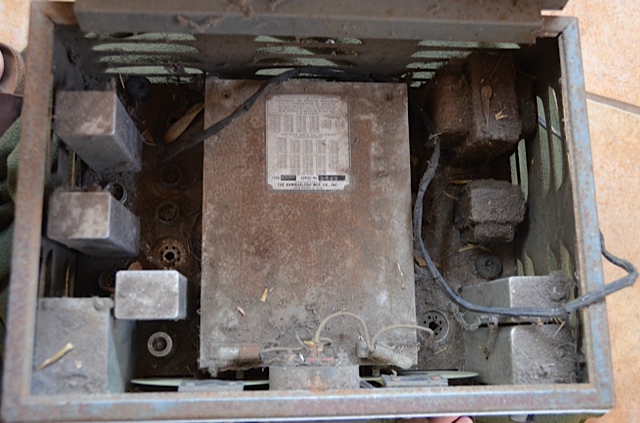
I took the radio home and put it on a bench in the garage. As I came and went
I would walk in front of the old receiver and wondered who previoulsy owned it, how many countries did they work and
what was I to do with it. There were periods in my past when I owned and
repaired/restored a few old ham radios like a Heathkit
SB300 receiver and Heathkit AT-1 transmitter.
However my main interest over the previous 10 years was developing my
homebrew full featured transceiver, the HBR-2000. Checking the serial number
I determined that it was built in 1941. Therefore it likely was used during
WWII in military service. After it would have been sold as surplus to most
likely a ham operator after they were allowed to operate once again. Who ever
the owner('s) were it had been modified and probably used for years in
somebody's hams shack as a faithful DX Chaser. I could not see myself junking
this beautiful piece of history. After all my daughter had found it for me.
One day I began thinking maybe I should convert the old boat anchour to a totally solid-state receiver. What ham can
not use a general coverage reciever to check WWV
and a few Short Wave Broadcast stations from time to time. Oh yes, keep the
front panel, knobs, tuning dials and S meter.
I had a number of receiver modules that I had used when developing the
HBR-2000 that I replaced with newer versions. I began counting them up in my
head and thought I may have enought to build a
complete receiver. I rummaged around my electronic work shop and came up with
the following modules:
A. Audio Output module.
B. AM and CW/SSB demodulator.
C. Front end mixer, diplexer and post amplifier.
D. 3.0 KHz and 9 KHz Band Width 455 KHz ceramic filters.
I had no excuse. The first step was to dismantle the whole receiver. I
removed all the transformers, tube sockets, knobs, crystal filter unit, BFO
coil box, front panel controls, S meter, front panel and then the two
frequency dials. Surprisingly the dials looked in good shape. The most
difficult items to remove were the knobs. They were frozen to the shafts. I
was only able to loosen two knobs. I tried every thing I could think of to
remove the knobs including de-rusting oil, etc etc.
So out with the Dremel-Saw and I cut into the set
screw holes and pried them off the shaft.
All that was left on the chassic was the large
Hammarlund double section variable tuning capacitor on the top and the bandswitch and associated band coils and capacitors in
the bottom. This then went into our kitchen dish washer with a very small
amount of soap followed by a heavy duty hot water rise cycle. Amazing what a
little soap and hot water can do to a filthy radio.
The following picture is the IF box. This is a direct copy of W7ZOI/WA7MLH
Hybrid Cascode General Purpose AGC IF Amplifier
found in the December 2007 issue of QST. The only changes to the circuit was
increasing all bypass capacitors to 0.2uF as the HQ120X uses an IF frequency
of 455 KHz. This was a simple choise as I was
familiar with this circuit and I did not have to use the HQ120X IF cans with
separate IF circuits.
The cascade hybride IF.
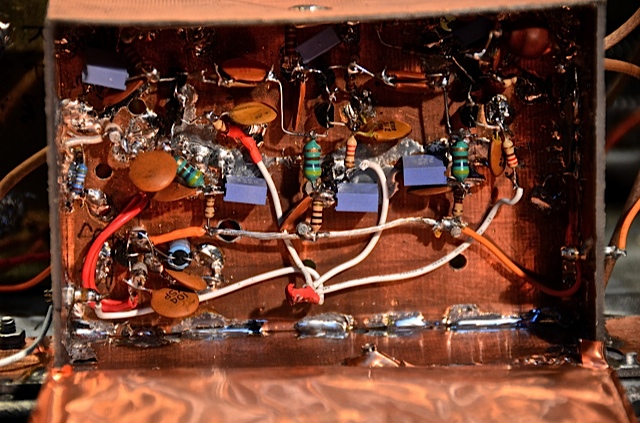
The second box from the left contains the double balanced diode mixer, post
mixer pre-amp and two ceramic IF filters. The box on the right hand side of
the chassic is the combined CW/SSB and AM product
detectors and audio amplifier circuits.
New Modules installed
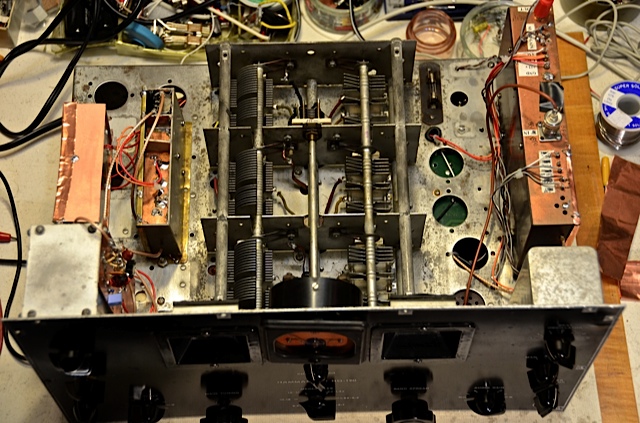
The BFO and VFO circuits employee FET's. I used the existing BFO coil and
band switched coil/capacitors for the VFO. The cover over the large two
section variable capacitor set was rusted and a friend offered to sand-blast
it and prime it for me. Here is a picture of the finished cover. I have yet
to spray paint it with aluminum paint. The cabinet is also being sand-blasted
and painted.
Ganged Variable Capacitor
Shield sanded and primed.
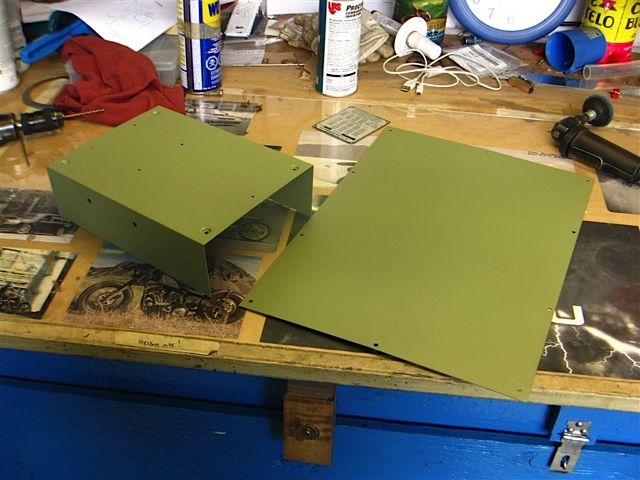
The front panel and knobs were cleaned with soap, water and elbo grease. I waxed the front panel with car wax and it looks
not bad though you can tell it has been well used. The cabinet was sanded and
then sprayed with anti-rust prime. I found a grey spray paint at an
automotive retail store that waa similar to the orginal grey used by Hammarlund for the cabinet of the HQ-120x.
I am very pleased with the outcome. The Hammarlund dials are beautifully
smooth to turn so I can quickly check band conditions across a wide spectrum.
The 9 KHZ Bandwidth AM IF filter sounds great on AM and the 3 KHz BW filter
provides single-signal reception for both SSB and CW signals. The solid state
HQ-120X now sits in a prominent place on the top shelf of my operating desk.
I am surprised how often I use it to listen to a favorite broadcast station,
cruise the short wave broadcast bands and check the time on CHU and WWV/WWVH.
My daughter and grand-sons think it is rather cool as well.
Finished. Even the dial and
S meter lights are LED's.
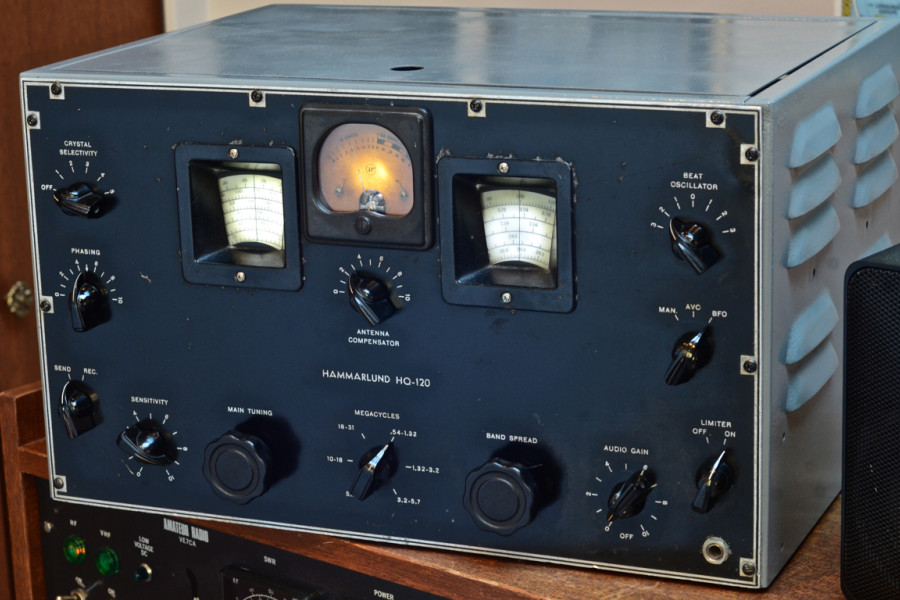
The only thing it lacks is the smell of tubes warming up when I turn it on.
You old timers know what I mean.
|








